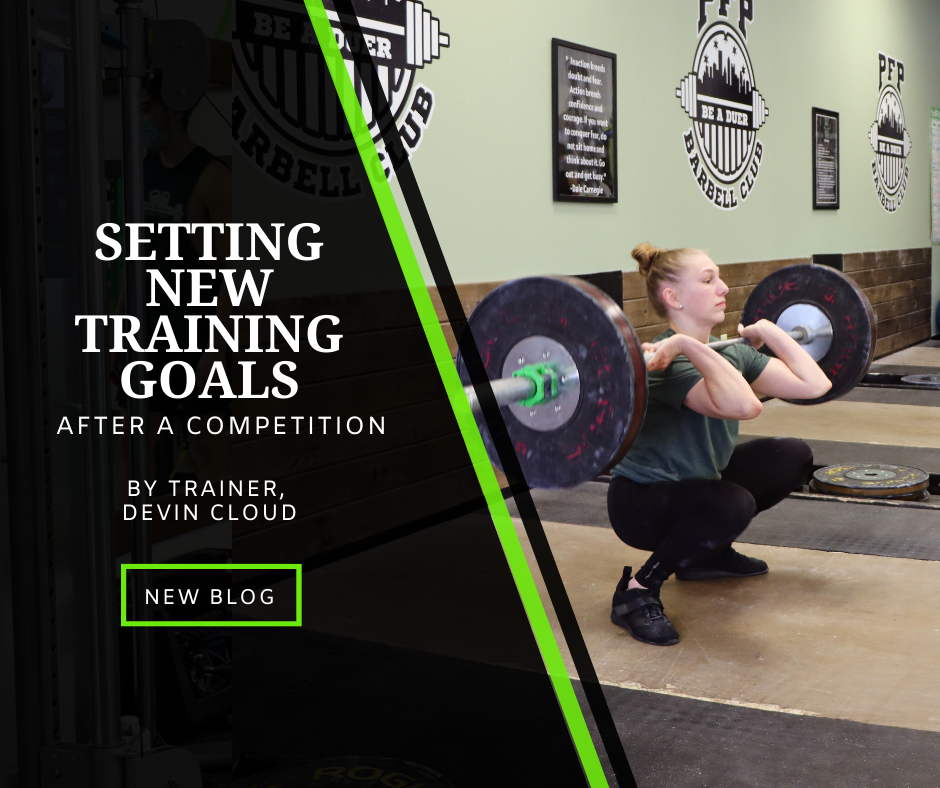SETTING NEW TRAINING GOALS AFTER A COMPETITION
Competing in your first competition or even just another one years down the road? Well, then, it's time to analyze and reevaluate your goals and what you’ve done. Whether it is hitting a new maximum weight, a new placing, or a new best time in an event, the time has come to restructure training and set forth new goals for yourself. The purpose at this point is to see what was done well and what might need improvement. This can come in the form of changing training frequency, entire movement patterns, training times, or trying an entirely new training style. Whatever you decide, the first step is the evaluation of yourself and previous training.
Competition Evaluation
and Goal Setting
When looking at your previous competition, the analysis should center around what was planned and what occurred. Maybe it was a weightlifting competition, and you only went 3 for 6 and didn’t get near what you were hoping for. Was it a technique or strength issue? Was it a readiness issue? In another instance, you're a sprinter, and you had a “best time” in mind for yourself, and you missed the mark. Was your initial acceleration poor? Is your top-end speed lacking? In both instances, there are ways to narrow down specific issues to target them more effectively. Once you feel you have properly diagnosed the issue at hand, it is time to set the necessary goals for fixing each problem.
In the case of the sprinter, creating “buckets” to fit yourself into is a good strategy. If the issue at hand is poor acceleration, then the training goals should align with that. Improving body position at the start in your blocks. Increasing strength level to have more force pushing out on the initial drive. Better mobility to access deeper ranges of motion in the hips, knees, and ankles. For the top-end speed bucket, you would want to focus on faster and more reactive factors like how fast and how much force you are putting into the ground with each step. Creating training more centered around strengthening your feet and ankles to withstand the high ground contact forces at top speed. You might need more plyometric training that focuses on multiple foot contacts and repeated high-speed movement.
In the case of the weightlifter, buckets can also be established. The first separation can be strength and technique. While each one can improve the other simultaneously, a more specific focus on one may be necessary. In the instance of technique improvement, your training might reflect more work on the lifts themselves. Complexes with a specific focus on positions and technique variation might be your best bet. Improving bar path, overhead position, and body position are all important considerations to be made. Your overall intensity on the lifts may start low, but with improvement, you can slowly begin to overload the technique more and more. In the instance of strength, your training might have more of a focus on overloading certain positions or just increasing your maximum strength in pulls or squats. Eccentric pulls or squats that force you to have longer times under tension can greatly improve your overall strength. More specific to weightlifting might be combining pulls with pauses at certain positions to improve your strength in that position. Pausing at the knee or just off the floor when pulling can expose issues you might have previously not known.
In each of these examples, we have diagnosed the issue and given specific ways to improve those issues. How does this look over an entire program?
Pathway to Accomplishment
Building to a proper goal means starting at the end and working backward. If you are working in a 12-week program model, there should be designed changes at specific intervals of that training. In the first three weeks, there might be the first part to an overall goal. For a weightlifter who is working on their bar path, they might start working from the hip to the overhead position. In the following weeks, another piece could be added, including starting from the knee position, working on moving well to the hip, and then overhead to involve more complexity to the skill. Eventually, you add in working from the floor to make the skill more specific to competing. In the end, you have progressed the training to adhere to the overall goal you were looking to accomplish. The same progression can be applied to any other training.
Once this process is complete and you either retest or compete again, you can start the process all over again. Planning and evaluating yourself and your training takes patience and a great deal of self-awareness. If you have the pleasure of working with a coach, schedule meetings or regular talks with them to keep yourself accountable and on track. Keep your goals in mind, be consistent with your training, and the work will pay off.

